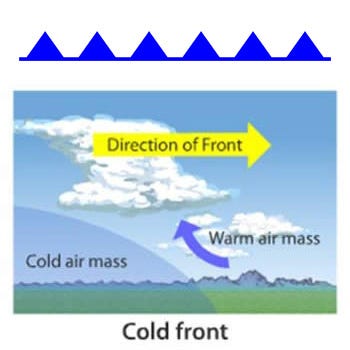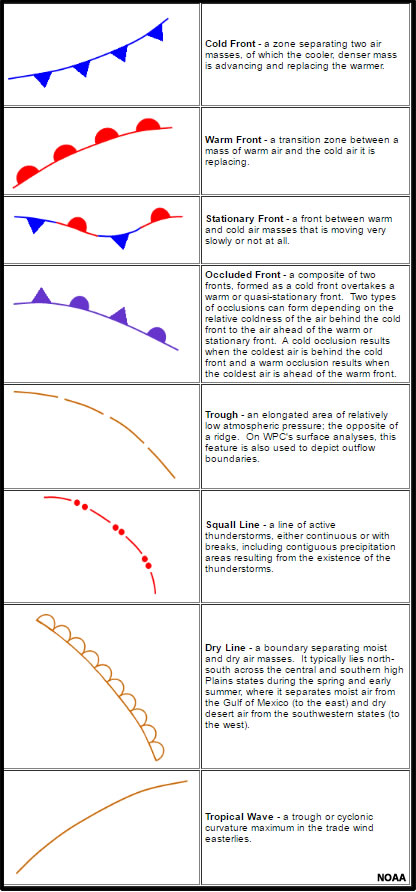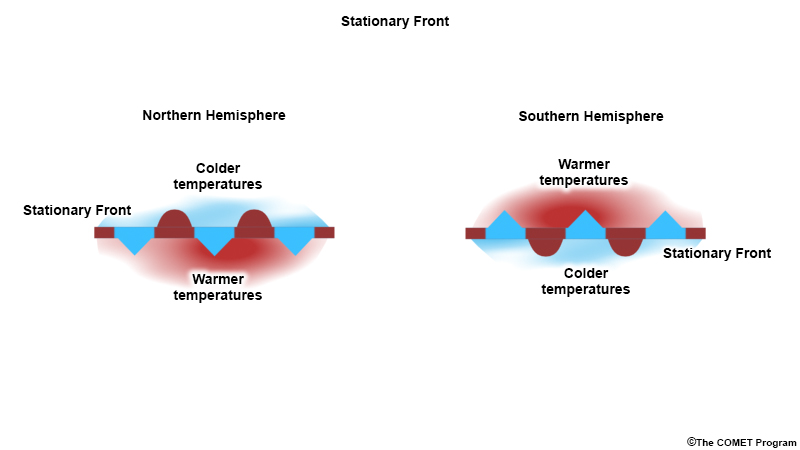A Stationary Front Is Associated With Which of the Following
Double win for cold air mass. Once this boundary resumes its forward motion it once again becomes a warm front or cold front.

What Is A Stationary Front What Weather Does A Stationary Front Bring
There are four types of fronts that will be described below.

. Minnesota wisconsin and michigana high-pressure system has developed over the oklahoma and texas panhandlesan occluded front has developed over southeastern nebraskathe warm front associated with. Whether it is present or not depends on the stability of the warm air mass. Warm areas to cold areas d.
Temperature moisture wind speed and especially direction pressure or pressure change and cloud cover and associated significant precipitation. You can make your own plots here. When the surface position of a front does not change when two air masses are unable to push against each other.
9 Surface wind patterns move from. Tie No clear Winner. Cumuliform cloudiness and precipitation can occur on either side of the front.
Here we will study the observed structure of the polar front. Finding Fronts - Or Not. The leading edge of an advancing cold air mass is a cold front.
If a front is not moving it is a stationary front. Weather Associated With Stationary Fronts. Cold Front Warm Front and Occluded front are examples of Temperature Inversion.
Mobile movable moving nonstationary. The meaning of STATIONARY FRONT is the boundary between two air masses neither of which is replacing the other. When a warm or cold front stops moving it becomes a stationary front.
The wind motion on both sides of the front is parallel to the front. But fails to beat the cold air mass. Immobile nonmoving standing static changeless constant stable steady.
Warm or cold front stops moving so the name stationary front. Cold areas to warm areas. SS - Ch 11 - TEST Regions.
Cold front warm front stationary front and occluded frontTo locate a front on a surface map look for the followingsharp. Warm air masses and cold air masses. D ie a boundary associated with two different air masses bit neither air mass replaces the othermay be associated with long lasting precipitaion and flooding Symbol.
- using Single Fields. A stationary front forms when a cold front or warm front stops moving. Follow the pointer.
Stationary Front Usually associated with multiple days of clouds and precipitation Occluded Front Marked by a purple line with alternating purple triangles and purple semi-circles all pointing in the direction of the frontal movement. It forms a wedge which pushes under a. Cold Air mass is the winner.
The divergent pattern of winds associated with highs marking the cores contrasting air masses sets the stage for an inevitable showdown at a front in this example the front is stationary. A stationary front may stay put for days. Now up your study game with Learn mode.
Stratiform cloudiness and precipitation are generally confined to the cold air side of the front. A flow of warmer air that. Cold fronts are indicated on weather maps by pointed cusps and warm fronts by semicircles on the side toward which they are moving.
A stationary front is a frontal system that forms at a fixed location when two air masses meet but neither is strong enough to replace the other. Low pressure to high pressure c. This front typically develops around the center of a low-pressure system during the formation of a cyclone.
Whether your meteorologist discusses cold fronts warm fronts or stationary fronts some atmospheric condition inevitably gets associated with it. On the right you can see the long-term Northern Hemisphere mean air temperature at 500mb for January contoured every 5C. A Stationary Front - as its name gives away - is formed when a cold or warm front stops moving.
See sketch Cold Fronts. If one air mass gains strength or the wind direction change it starts to move again as either a cold or warm front depending on the dominant air mass. 3 Here the color of triangle is bl View the full answer.
You just studied 20 terms. A draw a stationary front is formed. Note that the temperature gradient is strongest in mid-latitudes and marks the location of the polar front.
What is a Stationary Front. A stationary front may bring days of rain drizzle and fog. Both the warm and cold fronts if not moving with enough speed or strength to take over the other shall lead to the formation of a stationary frontal zone.
Ultimately the stationary front lies just on the warm side of the large temperature gradient associated with the frontal zone right. The warm air mass picks up a fight. Winds blowing parallel to the front instead of perpendicular can help it stay in place.
A stationary front is indicated by a combination of both. Warm Front Follow the pointer to section 4 12 read the information and answer the following questions. What type of air does a stationary front bring.
This front may last for days and winds blowing parallel to the front can lock it in place. A front that is not moving. Cold Air mass is the clear winner.
Occluded Front Type of weather sometimes thunderstorms but often weather clears Cirrus Latin for Curl. SS - Ch 11 - Quiz - Mapping South Pacifi. Cold Front Warm Front.
Normally either cold or warm fronts dominate any weather discussion or. Stationary fronts are said to be formed when a polar air mass loses its own characteristics and stops flowing in a particular direction. Warm fronts are marked on weather maps with a red line of half circles pointing in the direction of travel and mark the edge of an advancing warm air mass.
High pressure to low pressure b. Weather conditions often follow and are associated with a specific type of front. This is a result of the two masses of air pushing against each other with neither being able to shift the other.
SS - Ch 11 - Quiz Hist. Traditionally forecasters relied on one or more of the following fields to help define the location of a surface front. A stationary front is located across the great plains regiona large midlatitude cyclone in the open stage has formed over the upper midwest ie.
This happens when two masses of air are pushing against each other but neither is powerful enough to move the other.

How Weather Fronts Form And Give You A Headache Weather Science Weather Fronts Earth And Space Science

There Are Four Basic Types Of Fronts Can You Name Them By Weatherdectech Medium

Easy Explanation Of An Occluded Front With Diagram Science Struck Weather Lessons Weather Science Weather And Climate
Fronts Types Of Fronts Stationary Front Warm Front Cold Front Occluded Front Pmf Ias

File Stationary Front Symbol Svg Wikipedia

Nws Jetstream How To Read Surface Weather Maps

Fronts Types Of Fronts Stationary Front Warm Front Cold Front Occluded Front Pmf Ias

Fronts North Carolina Climate Office

Can You Read A Weather Map Teaching Weather Weather Map Weather Science

What Is A Stationary Front What Weather Does A Stationary Front Bring

Weather Diagrams Teaching Weather Weather Science Weather Lessons

Weather Fronts Materials Weather Fronts Warm Front Weather

Nws Jetstream How To Read Surface Weather Maps

The Following Page Is Designed To Help Pilots Acquire The Background Knowledge Of Aviation Weath Aviation Education Background Knowledge Decision Making Skills





Comments
Post a Comment